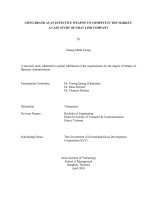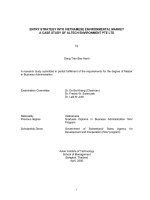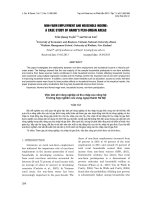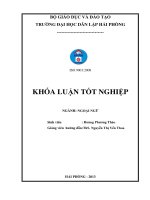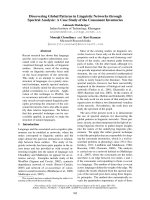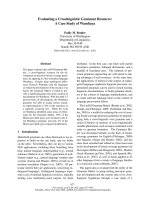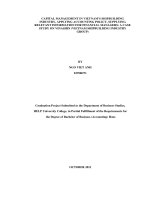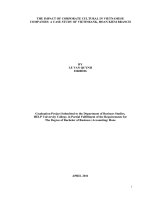15 FINANCIAL SITUATION – a CASE STUDY OF HANOI TRADE STOCK CORPORATION
Bạn đang xem bản rút gọn của tài liệu. Xem và tải ngay bản đầy đủ của tài liệu tại đây (459.45 KB, 103 trang )
MINISTRY OF FINANCE
ACADEMY OF FINANCE
Major: Corporate Finance
GRADUATION THESIS
FINANCIAL SITUATION – A CASE STUDY OF HANOI TRADE STOCK
CORPORATION
Company’s name: Hanoi Trade Joint Stock Corporation
Student’s name: Trần Khánh Nam
Class: 55/11CL.03
Intership supervisor: Associate Professor Ph.D Nguyen Thi Ha
Hà Nội – 2021
DECLARATION
I hereby declare that this thesis is on my own work and effort. The data
and outcome which are indicated in the thesis are truthful from practice of
internship company.
Author of the thesis
Tran Khanh Nam
TABLE OF CONTENTS
LIST OF ABBREVIATIONS
BEP Basic earnings power
COGS Cost of goods sold
EBIT Earnings Before Interest and Tax
NWC Net Working Capital
ROA Return on Assets
ROE Return on Equity
ROS Return on Sales
USD United States Dollar
VND Vietnamese Dong
LIST OF TABLES
LIST OF CHARTS
PREFACE
1. The importance of the research topic:
In 2019, when the world economy was in conflict between US – China
Commerce, with political problems have caused the instability of the World
Commerce and affected business, investment decisions and global
commercialization, Vietnam’s economy grew on its own way. The
international
financial-monetary
market
and
oil
prices
fluctuated
complicatedly that made a negative impact on credit growth, expectations and
market sentiment. In Vietnam, besides the positive results which was achieved
in last year, the macro economy had stability. There are many difficulties and
challenges such as climate affects quality and quantity of crops; the African
swine fever epidemic affect the livestock industry in 63 provinces and cities
directly under the Central Government; key export products have slow
growth; Disbursement of public investment did not meet the plan.
The economy in 2019 had grew significantly. Economy had improved
quantity and quality, specifically, the gross domestic product has an
impressive growth result of 7.02%, exceeding the target set by the National
Assembly of 6.8%. This is the second consecutive year that Vietnam's
economic has reached over 7% since 2011. In the general growth of the whole
economy, the agriculture, forestry and fishery sector increased by 2%,
contributing 4.6% on the general increase. The prosperity of industries also
made export turnover the focus of 2019. By the end of 2019, the total importexport turnover reached 517.26 billion USD, of which the export value was
264.19 billion USD. USD (up to 8.4% of an increase of 20.49 billion USD
compared to 2018). The balance of trade in goods in 2019 was estimated to
have an export surplus of 9.9 billion USD - the highest level in 4 consecutive
years of trade surplus.
As the market economy develops, corporations, groups, economic and
financial systems and corporate financial situation play a crucial role.
"Finance" is a prerequisite to success and failure of an organization.
Therefore, the financial situation always attracts a lot of attention from
managers and analysts to promote and maintain strengths as well as overcome
weaknesses. Business managers need to understand the operational and
financial situation of the unit to come up with appropriate strategies and plans
to improve operational efficiency. Then, the units should carefully analyze
their business activities, especially the financial situation to understand the
reality as well as the future direction of the business.
2. Objectives and commissions:
Objectives: Proposing solutions to improve the financial situation of
Hanoi Trading Joint Stock Corporation. To achieve these goals, I performed
the following tasks:
- Systemize arguments about the financial situation of the business
- Study about Hanoi Trade Joint Stock Corporation in the period from 2017 to
2019
- Through a general assessment of the financial position of the corporation,
including achievements, limitations and causes, and propose solutions to
improve the situation.
3. Scope of the research:
In this work, I focus on evaluating the financial situation and position of
Hanoi Trading Joint Stock Corporation in the period from 2017 to 2019.
4. Methodology and Data:
The methods are mainly applied:
+ The method of comparing and synthesizing the actual data collected during
the internship at the company, the financial reporting system for the year
2017-2019 and the information obtained from the accounting - finance to
analyze the situation of fluctuations, development trends. Then, the manager
will give appropriate solutions to improve, stabilize and develop the
company's financial situation.
+ There is also a combination of other methods such as balance method, ratio
method, trend analysis ...
5. Thesis Structure:
Regarding the topic structure, except for the introduction and conclusion,
the thesis layout consists of 3 chapters:
Chapter 1: Overview of Corporate Finance
Chapter 2: Financial situation Financial situation of Hanoi Trade
Joint Stock Corporation in recent period
Chapter 3: Solutions to enhance corporate financial situation
Due to limited knowledge in both theory and practice, my writing cannot
avoid errors. I look forward to being guided by the company and the teachers
to make my writing more complete.
Thank you sincerely!
CHAPTER 1
OVERVIEW OF FINANCIAL SITUATION OF A COMPANY
1.1 Corporate finance and financial management
1.1.1 Corporate finance and financial decisions
1.1.1.1 Definition of corporate finance
A firm is an economic entity which carries out goods production or
services supply of the market to gain profits. A firm operates by combining
input resources to generate outputs (maybe products or services) for profitable
sales.
Corporate finance is economic relations in the form of arising value with
the creation and the using of monetary funds of companies in course of its
operation.
Corporate finance is the process of monetary funds of creation,
distribution, using and advocacy associated with operation of companies.
In the other view, Corporate finance is a method of mobilizing,
allocating and using financial resources of companies to achieve business
goals.
The main financial relations in companies:
● Financial relation between companies and the State.
● Financial relations between companies and laborers in enterprises.
● Financial relations between companies and economic subjects and
other social organizations.
● Financial relations between companies and their owners.
● Financial relations within companies.
1.1.1.2 Financial decisions
Investment decision
Investment decision is known as a capital budgeting decision associated
with how efficiently a company invests its available funds in long-term assets.
This decision has various investment activities of a company such as
acquisition, expansion, replacement and modernization of long-term assets.
Further, it is also concerned with whether a company should sell its own
business division or run an advertisement campaign or undertake research and
development (R&D) projects. So the key goal of investment decisions is
dealing with investment activities that have long-term implications for the
company's expenditures and benefits, which are typically measured in cash.
Investment decision is the most important decision of all financial
decisions because it determines a company’s success or failure. A wise
investment decision creates value for the company and then increases the
shareholders’ wealth. Adversely, a wrong investment decision will result in
losing value and destroying shareholders’ wealth.
Financing decision
A company’s financing decision is considered between long-term debt
and equity that the company uses to operate. The financial manager has two
concerns in this area. Firstly, how much should the company borrow? That is,
how to consider between debt and equity to make the best decision? The
chosen balance of debt and equity will affect both the risk and the value of the
company. Secondly, what are the cheapest sources of funds for the company?
Because of these and other financing factors, every investment decision
must be made under the assumption of WACC that includes each of the
different sources of capital that are based almost on the long-term target
weight. A company creates value by producing a return on assets that is higher
than the required rate of return on the capital needed to fund those assets.
Dividend decision
Dividend decision refers to a company's income distribution policy to its
shareholders. Shareholders are rewarded for investing in the company. To
make dividend decisions, the chief financial officer is responsible for
determining the dividend payout ratio, which reflects the ratio of the income
used for the company's future investments. As can be seen, this decision is
related to the balance between current earnings of shareholders (in cash
dividends) and potential future capital returns (generated from retained
earnings). Therefore, it strongly affects the wealth of shareholders.
Long-term financial decision:
Strategic decisions have long-lasting influence on existence and
development of companies. Each of these decisions need to be made
carefully, analyzed scientifically to ensure that minimize risks. Long-term
financial decision includes:
- Long-term investment decision: make a decision on an investment
project, opportunities of investment that company could invest under limited
financial resources for maximizing value for owners.
- Decision on raising long-term capital: the decision on which sources
need to be raised long-term capital and how much scale to maximize value for
owners.
- Decision on profit distribution policy of enterprise: It is a decision to
choose how much profit should be spent to owners, how much profit should
be spent to re-invest in enterprises to maximize value for owners.
Short-term financial decision: These are operational decisions,
which do not affect the existence and development of companies. Some
short-term financial decisions:
- Decision on reserving capital in cash.
- Decision on receivable debts.
- Decision on payment discounts.
- Decision on inventory capital reserves.
- Other short-term financial decisions: decisions on depreciation of
fixed assets, decisions on provisioning…
1.1.2 Financial management
1.1.2.1 Definition and roles of corporate finance management
Definition of corporate finance management
Corporate finance management is selecting, making decisions and
organizing implementation of financial decisions to achieve the main goals of
the company. Because financial decisions are all about the creation,
distribution and utilization of the monetary funds during the operation of a
company, corporate financial management is also seen as the process of
planning, implementing, adjusting and controlling the monetary funds to meet
the company’s needs.
Corporate finance management has three main decisions: investment
decisions, capital mobilization decisions, and dividend decisions in order to
make profit to business owners.
Financial management is a division, is the leading important content of
corporate management, it has close relationships and affects all aspects of
business operations. Most corporate management decisions are based on the
results drawn from the financial evaluation of financial management
activities. This comes from the role of financial management for enterprises.
1.1.2.2. The role of financial management in a company
The role of corporate finance management in business operations is
reflected in the following main aspects:
- Mobilizing capital for the operation of the company: Make sure the
operation of company has normal and continuous performance and that
depends mostly on the organization of mobilizing capital of the firm. So
properly funded policies help companies reduce financial risks and have a
great impact on the performance to maximize business value.
- Organizing capital economically and effectively to improve business
performance of companies: The selection of optimal investment projects on
the basis of consideration and comparison among profitability ratio, cost of
capital mobilization and level of risk, etc, has created a premise for saving
and high efficiency of capital use. The organization of timely and sufficient
capital mobilization will help enterprises take advantage of business
opportunities, increase their revenue and profit. Choosing a suitable form and
method of capital mobilization, ensuring optimal capital structure can help to
reduce cost of capital use, contribute to increase ROE and profits of
companies. In addition, mobilizing the maximum amount of existing capital
to business activities can help enterprises avoid losing due to capital
stagnation, increase asset turnover, reduce borrowed capital, thereby reducing
loan interest payment to contribute to increase profit after taxes of enterprises.
- Supervising
aspects
of
the
entity’s
operational
activities
comprehensively: By analyzing the financial situation of companies and
implementing financial indicators, financial administrators can control
promptly and comprehensively business’s activities, thereby pointing out the
exists and untapped potentials of the business.
1.1.2.3. The contents of financial management in a company
The contents of financial management include the following main
contents:
- Participating in the evaluation and selection of investment decisions:
Prospects of the business in the future depend heavily on long-term
investment decisions such as investment decisions to innovate technology,
expand production and business, produce new products ... To make
investment decisions. Enterprises must consider many aspects of economy,
technology and finance. In particular, the financial aspect must be considered
in terms of the cost of capital and the expected return on investment, or in
other words, the cash outflow and the cash flow associated with the
investment to evaluate opportunities. financial investment. This is the process
of making an investment estimate and evaluating the financial performance of
an investment…
- Determine capital needs and organize capital mobilization promptly
to meet the operation’s need
The manager must determine the capital needs necessary for the
operation of the business in the period (long-term capital and short-term
capital). Next, the organization mobilizes capital sources in a timely,
sufficient and convenient manner for the operation of the company.
- Effectively use
existing capital, strictly managing revenues,
expenditures and ensuring solvency of enterprise.
The financial managers must find all measures to maximize the current
capital mobilization of enterprises into business activities, promptly release
the stagnant capital, closely monitor and perform well the payment and
collection. recover money from sales and other receivables, and strictly
manage all costs incurred in the operation process. of enterprises, often
looking for measures to balance capital revenues and expenditures in cash, to
ensure that the enterprise is always able to pay off due debts.
- Implement profit distribution, budget and utilize enterprise’s funds
Reasonable distribution of after-tax profits, appropriation and good use
of enterprise funds will contribute to the development of enterprises, improve
the material and spiritual life of employees, and harmonize benefits. Owner's
immediate benefits with long-term benefits. - business development.
- Regularly controlling the operations of enterprise.
Through daily revenue and expenditure, financial statements, and
implementation of financial indicators allow businesses to control their
financial situation. On the other hand, through periodic analysis of the
financial situation of the business to evaluate the efficiency of capital use,
strengths and weaknesses in management, predicting the financial situation of
the business, from there Help leaders and managers to make decisions to
adjust appropriate business and financial performance of the business in the
coming period.
- Implement financial planning
The business's financial activities must be planned through a financial
plan, a superior financial plan that will help unit administrators make the right
financial decisions to achieve the goals. business spending.
1.2. Financial situation of a company
1.2.1. Definition of financial situation
The financial position of a company is determined by the results of its
operations in its financial statements: the cash flow statement; Profit growth
in the statement of profits and losses, assets, liabilities and equity in the
balance sheet.
Assessing the financial situation of an enterprise is the review and
analysis of the financial management results of an enterprise through the data
on the financial statements by combining the use of methods, tools and
techniques. analyzing, thereby pointing out what has been done, not yet done
and predicting what will happen. at the same time find out the causes and
influence of these factors on the business results of the enterprise, thereby
proposing solutions to take advantage of strengths, overcome weaknesses, and
improve the quality of business management.
1.2.2 Indicators for assessing financial situation of a company
1.2.2.1 Assets and Assets Structure
Analyzing the situation of assets, investors and administrators will learn
the investment situation using capital mobilized, know how to mobilize
capital when is suitable for business and serve the business purposes of the
business or not?
Asset structure analysis is done by calculating and comparing the
variation between the analysis period and the base period according to the
proportion of each asset division. (Current Asset, Non-current Asset,
Receivable, Inventories, etc) of total assets.
By analyzing the situation of assets in the business cycle, management
makes decisions: what types of assets need to be invested and when is the
right time to invest? Increase or decrease inventory? Inventory at what level
and what level is reasonable? It is crucial to meet market demand without
increasing inventory costs or maximizing profits with minimal increase in
inventory costs. The analysis also helps managers to come up with suitable
payment policies that both encourage customers and suppliers, and promptly
recover capital and take advantage of suppliers' capital, ...
- The current asset ratio: is the ratio describing the proportion of
current asset in total asset of a company, it is calculated by dividing the
current assets by total assets
Current asset ratio =
- The non-current asset ratio: is the ratio describing the proportion of
non current asset in total asset of a company, it is calculated by dividing the
non-current assets by total assets or use (1 – Current asset ratio)
Non-current asset ratio =
Current asset ratio and Non-current asset ratio show the overall structure
of the company's assets. 2 ratios show the balance between short-term assets
and long-term assets of companies.
Working capital management is critical for short-term assets and is a
measure of liquidity. This capital management is similar to revenues,
expenditures, cash and inventory. The purpose of working capital
management is to ensure that the business can do business and that the
company is responsible for paying off its short-term debts. Working capital
management has the role of effectively overcoming overdue debts.
1.2.2.2 Sources of capital and capital structure
Capital is a factor and an essential number one factor for the
establishment and development of a company. To achieve the purpose of
company business, a company needs to have enough capital to build the
necessary assets for its business activities. In order to mobilize capital for
operating activity, companies can use so many different sources. They are
basically equity and loan sources.
To make sure the effectiveness of operation, the company must mix both
sources of capital: equity and liabilities. The combination of two sources
depends on the characteristics of the company’s operation, the decision
making of the manager that based on consideration of the company’s
operation and financial situation.
Situation of capital structure and resources of capital
Researching the size and structure of capital means studying the capital
mobilization situation of enterprises to know from which sources and how
capital is raised, how the capital structure is determined: independent or
depends? Thereby, the financial managers will adjust the capital mobilization
policy to suit each specific period of the business.
+ Indicators that indicate capital scale include value of total capital and
each category of capital in the balance sheet
+ Indicators that indicate capital structure are determined as the formula:
Proportion
of
=
Value of each capital source
each capital source
Total liabilities and equity
x100%
Solvency ratios:
Debt ratio
=
Total debts
Total assets
Total equity
Equity ratio
=
Total assets
Equity ratio = 1 – Debt ratio
To make sure the efficiency of their business, companies often combine
two sources of capital: equity and liabilities. The association depends on the
characteristics of the industry in which the company operates and the
manager's decisions are based on a study of the company's financial position.
When company choose the source of capital mobilization, followings
targets are considered:
- The time period of invested asset
- Goals of financial structure, capital profitability
- Possibility of each source mobilization
- Cost of each source of capital
When studying capital situations, the tables are made based on the
comparison of each indicator, each category to determine the absolute and
relative difference to make an assessment.
Assessing sponsorship activities of company:
Working capital source of company has 2 parts:
+ Net working capital (NWC): is a long-term capital source to finance a
company's current assets in order to make sure the regular and stable business
activities of the company.
+ Temporary working capital: Short-term capital source to finance the
working assets of a business to meet the company's cyclical needs.
In contrast, for a company's assets, we divide it into assets with liquid
assets (conversion to money less than 1 year), fixed assets and long-term
investments known as Long-term assets (it has a payback period of more than
1 year.)
To create 2 types of assets, there are 2 sources of capital: regular capital
sources and temporary capital sources. Equity sources, long-term liabilities
with maturity of more than 1 year are regular sources. In contrast, short-term
liabilities are those with maturity of less than 1 year called temporary capital.
The regular source of capital is firstly invested to form long-term assets,
the rest and temporary capital are invested to form current assets. At that time,
the difference between regular capital and long-term assets is called net
working capital (NWC).
NWC = Regular capital sources - Long-term assets
Or NWC = Current assets - Short-term liabilities
This is an indicator to assess working capital financing method of
enterprise, to assess safety level or financial risks in operations of enterprise.
There are 3 possible cases:
- Case 1: when current assets are higher than short-term liabilities: it
means working capital is always positive. At that time, there will be a stability
in business activities of enterprise because there is a part of working capital
that regularly sponsors fixed assets to use for business activities.
- Case 2: when current assets are lower than short-term liabilities: it
means working capital is always negative. This is a worrying sign for
enterprises operating in industry or construction. This is a sign of wrong use
of capital, the balance of payments certainly has imbalance, the ratio of shortterm debt payment < 1. However, for commercial enterprises, this way of
financing can still happen. Because this industry has a fast turnover rate of
capital.
- Case 3: When current assets are equal to short-term liabilities: it
means that regular working capital is always equal to 0. This funding method
shows that only fixed assets are financed by long-term capital, while current
assets are funded by current capital. This case also does not create stability in
production and business activities of enterprise, especially for enterprises with
slow capital turnover.
1.2.2.3 Revenue, Expense and Income
- Revenue: This clause is used to offset business capital and costs
incurred in the operation of the company. A company's profit is also
determined by its revenue. Revenue shows the company's financial position,
by giving directions for the company's future development. Besides, revenue
is also a factor confirming the existence and development of an enterprise in
the marketplace. Therefore, analyzing the cause of the increase or decrease of
revenue in the business cycle is extremely important. Regular revenue
analysis is needed to exploit the potential of the business to increase revenue
and maximize profits for the business. Analyzing the revenue situation helps
managers see the advantages and disadvantages in the revenue generation
process, through analyzing the factors that increase or decrease revenue to
overcome, limit, and eliminate negative factors; promoting more positive
factors, promoting the company's strengths.
- Expense: Is the cash outflows, future cash outflows or allocation of
past cash flows from the company activities. Based on the financial report, we
can calculate the cost. Then calculate the goals, cost-to-revenue ratio to
change measures and find solutions that match the goal of minimizing costs
and maximizing profitability of the company. The company wants to
maximize profits, if a company only cares about revenue and ignores costs, it
will be a huge mistake. Because the cost shows the efficiency of production
and business activities of the business. If the costs are too large, the growth
rate of cost is greater than the growth rate of revenue, which proves that the
business has not used resources effectively.
- Income: An aggregate indicator showing the results of the business
production process. Income shows the quantity and quality of the enterprise
fully, reflects the efficiency of labor, materials, ... Is business efficiency really
high or low? To understand, we need to analyze the relationship between total
revenue, total cost and the income earned by the business. At the same time
increase accumulation, expand production, improve the lives of workers.
Conversely, if the business has a loss, it will make the financial situation
difficult.
1.2.2.4 Cash Flow situation
Cash flows is performed by examining the cash flows from three
activities: cash flows from operations, cash flows from investing, cash flows
from financing.
Cash flow from sales and cash receivables minus payments for goods
and services, wages, wages, and interest. Investment cash flow includes
money received from the sale of real estate, factories and equipment,
investments and other permanent assets less money spent on buying long-term
assets. that term. Cash flow from investing in a healthy growing business will
often represent an outgrowth of revenue. Cash flow from financing activities
is dividends and repayment of liabilities. A business can finance internal
growth either with cash generated by the activity or with external money from
the owner and the borrower.
Cashflow situation can be examined by analyzing the occurrence of
sources and uses of cash through following steps:
- Determine the occurrence of sources and the using of cash
Move the balance sheet categories into columns. The next step is to compare
the value at the beginning with the value at the end to find out the changes in
each category. Any changes should be checked and reflected in the source
column or column using the following methods
+ “Use of cash” is corresponding to the increase in assets or decrease in
equities.
+ “Sources of cash” is corresponding to the increase in equities or
decrease in assets.
When calculate the sources and the using of cash, be carefully
+ Calculate detailed category
+ Regarding the category of depreciation and provisions, if there is an
increase, this will be put in the sources of cash and vice versa.
- Make a table of sources and the using of cash
Arrange accounts related to the use of cash and cash resources in the
form of a balance sheet, then evaluate the overall situation of cash increase
and decrease: which activities the company uses. The next stage can be raised
based on these assessments.
- Cash flow ratios
Cash flow margin ratio: assess the ability to generate money from
operating activities compared to the revenue achieved
Cash
flow
margin ratio
=
Cash flow from Operating activities
Net Sales
Sales in cash to sales of goods and services ratio shows the level of
collecting money from sales of goods in the period, assessing the ability to
recover money from sales
Sales in cash to sales of goods and
services ratio
=
Sales in cash
Sales of goods and services
Interest coverage ratio: assess the ability to generate money from
production and business activities that meet the interest payment requirements
Interest coverage
ratio
Net cash flow from operating activities +
=
Interest paid
Interest paid
Current liabilities coverage ratio: consider the ability to pay short-term
debts of businesses through operating cash flow. Thereby, assessing the ability
of the enterprise to make money from business activities is sufficient to pay
debts or not

